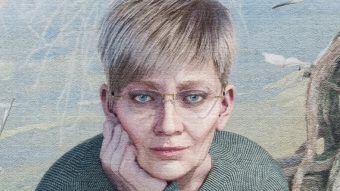
Published on Show Me Mizzou May 5, 2021
In 2019, the Department of Theatre teamed up with the Thompson Center for Autism and Neurodevelopmental Disorders to create a sensory-friendly production of the children’s book Corduroy. That’s the kind of partnership theatre Chair Heather Carver fosters on and off campus to make the magic of theater accessible to all. The play brings to life a story about teddy bear Corduroy and his owner, Lisa, one of the first Black characters in children’s literature. To make the show accessible to children with autism, the all-student crew softened the sound and lighting, created a zero-level stage, and allowed the audience to come and go as they pleased. “Part of our mission is that we don’t want to leave anyone behind,” Carver says.
Theater is just one of numerous ways MU builds bridges through the arts. Campus opens its doors through classes in art and instrumental music, a variety of performances, and exhibits at museums and galleries. The Artist in Residence program, a collaborative initiative through the School of Visual Studies, Museum of Art and Archaeology, School of Music, Department of English and Department of Theatre, hosts artists from across the globe who connect with all aspects of campus life. And, true to the mission of a land-grant university, engagement extends well beyond Columbia’s city limits.

“Sometimes when people think about the arts, they imagine a select group that goes to galleries, museums and concert halls,” says Pat Okker, dean of the College of Arts and Science. “All of those things are really important, but we have to expand on those traditional places to make sure people have real opportunities for significant engagement with the arts.”

School of Music Director Julia Gaines has been working toward this goal by offering classes such as the popular Jazz, Pop and Rock; Introduction to Soul and Country; and Songwriting and Beat Making. The latter offers students a chance to explore the combination of lyrics and melody and provides an avenue into the widely popular freestyle world where lyrics typically accompany only rhythm, or beats.
“We need to get out of our bubble,” Gaines says. “I’d like students to know the School of Music in a more robust way all across campus.” This priority complements the school’s strong community presence. Students perform at most local religious institutions and teach instrumental lessons through the Community Music Program.
Community involvement is key to Art on the Move in the School of Visual Studies, where students, faculty and alumni exhibit artwork statewide, often in their hometowns. The goal is to reach every Missouri county, says Lee Ann Garrison, the school’s director. In another Art on the Move initiative, Art in Empty Storefronts, a collaboration with MU Extension, students display their work in the windows of vacant buildings, increasing art exposure while fostering economic development. “Someone might look at that storefront and think, ‘I can do something with that space,’” Garrison says.
Okker is grateful to communities for sending their artists to Mizzou: “The high school teachers have nurtured these kids in the arts. They trust us to continue their development, and then we send them back to their communities.”
Art creates culture and helps us understand the world around us, Garrison says. “When we look back historically, we always study what the artwork looks like. Artifacts left to us bear witness to a time and place and to who we are.”
To read more articles like this, become a Mizzou Alumni Association member and receive MIZZOU magazine in your mailbox. Click here to join.



